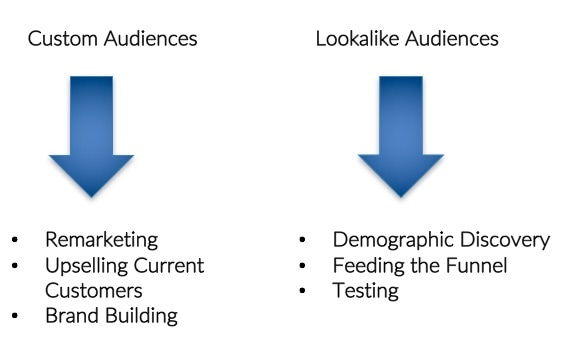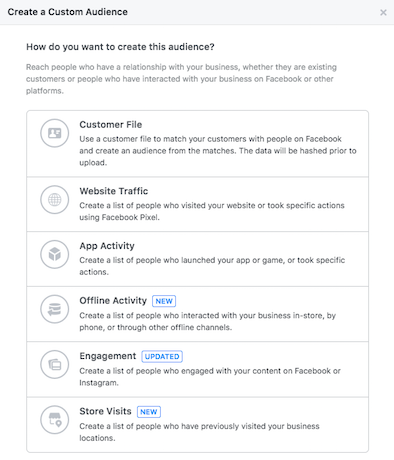Facebook Lookalike Audiences have become an essential part of jump-starting, re-starting, and expanding any Facebook campaign. In this post, you will learn the why behind lookalike audiences: Why are they needed? Why do I need to use this black box of targeting?
You will also learn how they can help your Facebook marketing efforts: How do you select your Custom Audience sources for Lookalikes? How do Lookalike Audiences help your regular targeting efforts? If you don’t already know how to create Custom Audiences & Lookalike Audiences, the Facebook help page has that covered with their Create a Lookalike Audience instruction, and check out our PPCHero article on 3 Tips to Better Understand Facebook Audiences for more details on audience building.
Lookalike audiences can produce strong results when your audience targeting is lacking, stale, or when you experience a campaign slump. They can also help you discover new audiences when you are beginning a new initiative, stepping into an account management role with a new client, or opening up a Facebook ad account for the very first time. Below are the key strategies to consider when you start testing Lookalikes, including the selection of your Custom Audience sources.
First Thing’s First: Why Lookalike Audiences are so essential to Facebook Marketers
Lookalike Audiences have come a really long way, as Facebook’s AI has gotten better at finding key demographic and interest markers. It’s almost eerie how accurate the algorithm has become at finding the exact customers you’re looking for. And as with all things Facebook, it’s a bit of a black box when it comes to understanding how the machine works. Regardless, Lookalike Audiences should be a part of every Facebook marketer’s toolbelt for three main reasons:
1. They allow audience expansion without the risk of “poking and hoping” with interest, job title, or other demographic targeting. In fact, many of the top Facebook marketers purport the value of testing Lookalike audiences before beginning a general targeting strategy, in order to discover your most valuable demographics. I agree that there is value to this technique to maintain a safe and effective targeting strategy. If you have the Custom Audience with over 1000 unique users, don’t hesitate to start with marketing to that base and feeding your funnel through those Custom Audience’s Lookalikes. Don’t blast with a fire hose. Start with a water gun.

2. If you have robust sources for lookalikes (remarking site traffic, email lists, HubSpot or Salesforce data sources, previous ad activity or video views, etc.) and they contain at least the recommended 1000 unique users, there’s absolutely no reason to avoid using those resources to develop audiences beyond what manual, human targeting can do. Sorry humans. #machinelearningforever You can use audiences as small as 100 unique users, but it isn’t recommended as the algorithm has difficulty finding audience similarities with too little starting data.
3. Once you get your Lookalike audience tests up and running, they are generally low maintenance. Since the Facebook algorithm is doing most of the heavy lifting for you, very little adjustment needs to be made during the initial testing period. This isn’t to say that Lookalike Audiences require no geographic, age group, or other demographic trimming. All audiences require some attention and revisions over time. But Lookalikes allow more of a “plug and play” option that every busy marketer should be tempted to test.
So, How do Lookalike Audiences work Anyway?
Lookalike audiences are used to reach new people who are likely to be interested in what you have to offer, due to their similar characteristics to a “root” audience you provide in the form of a Custom Audience. Facebook has said that demographic information and interests are the key identifiers when they sweep the platform for users similar to your Custom Audience.
When you create your Lookalike audience, you can choose the amount of wiggle room to give, or the size of the Lookalike Audience from 1% to 10%. The percentage you give indicates how similar you’d like Facebook’s Lookalike to be to your Custom Audience.
Facebook’s algorithm proves to be very sophisticated, since country of origin doesn’t matter when you’re selecting the Custom Audience. For example, you can take a group of users in Finland and use them as the basis of a South African Lookalike Audience. This really drives home the fact that Facebook has confidence that they can find similar characteristics across cultures and geographic areas. That’s some powerful stuff and a one heck of a promise.
Ok, that’s great but…What are the key benefits?
Lookalike audiences allow marketers to target very specific demographics without hitting an audience full-blast and creating a frequency problem – a plight that many Facebook marketers can relate to. Lookalikes allow larger audiences to be targeted without the risk of overreach and among the safety net of Facebook’s algorithm. You may have experienced this yourself. As your narrow Facebook audiences near perfection, it’s possible they may get smaller and smaller (remarketing audiences among small businesses, anyone? B2B clients with very specific job titles, education, and interests anyone? Clients that demand the safety of a overly-narrow target, anyone?) which creates a frequency problem.
For example, I have a SaaS client with a very specific job & skillset target. We want to reach those who are skilled in their field – not students or entry-level kids who can’t persuade their boss to buy. But we also don’t want to give a highly technical ad to a management or c-suite level employee. Because of this, the natural audience is very specific and it creates a frequency problem. We have the natural ability to serve a ton of ads to a very small pool of users. The problem is frustrated with the limitation of geographic and language targeting. This resulted in high saturation upon initial audience testing. But the audience was so perfect, we really wanted to take advantage of these types of people without sacrificing quality.
We built our lookalikes based on those visitors who had been to pages of the site that were of similar interest as what our ads were offering, making use of specific remarketing lists filtered by words in the destination URL (blog posts and page topics.) This tossed all job targeting out the window, but instead based our audiences on the confidence that we had smart professionals visiting the client’s website. And the targeting wasn’t based on the whole website, just the pages that indicated their interest in very specific products. This is the luxury of having a high traffic website, to be sure, but the same technique could be used with sales lead lists, current customer lists, or email lists.
The results were terrific. In testing Lookalikes, we saw conversion rates double and found ourselves in wide open country when it came to ad frequency.

Once you have your Custom Audiences and Lookalikes populating, you can use the Facebook Audience Insights tool to discover key demographic markers as you filter by Custom Audiences, including Lookalikes. For example, thanks to the test referenced above, we were better able to exclude those outside our targeting (salesmen, administrative types) and make device targeting adjustments to make our handpicked Facebook audiences become more effective.
The possibilities of where you source your root audience are almost endless, which is what makes Lookalike audiences so exciting!
What are the best sources for Lookalike Audiences?

There are a few things to keep in mind when you’re selecting your Custom Audiences for a Lookalike test:
- If you have enough site traffic, subdivide your visitors by product type. Use of blog audiences is helpful too, so you can target based on user interest. For example, a retailer selling hardware can create a lookalike audience based on an audience created from URLs of all hardware products and blog posts containing words like “hardware”, “hinge”, “handle”, “parts” etc. Use Google Analytics to uncover which pages are popular as well as relevant.
- Check out this resource on Engagement-Based Facebook Ad Targeting Options from Search Engine Journal and the brilliant Susan Wenograd. Once you have your remarketing lists honed in, they are a solid gold source for Lookalike Audience building.
- Upload a churned or current customer list so Facebook can find a profile that matches your current customer base – loyal or not. Be sure to split your audiences based on their engagement if you’re able.
- Take note of where your best customers and leads come from. If you have a page of your site that just got pummeled with Redditors because they thought your meme was cool, be sure not to use that page as your source. The same goes for email lists – when you have the luxury of volume, use only your most engaged user lists as your Lookalike Audience source.
- You should advertise different messages when possible, based on the user’s interest.
Things to keep in mind as you begin to test:
- What do you want out of the Lookalikes? Are you seeking lower saturation as the example above? Will you be testing demographic targeting against the Lookalikes in an A/B test? Consider these things before you jump into targeting. A/B testing may give you a better idea of value instead of testing Lookalikes on their own. But if your budget and time are limited, starting with Custom Audiences and Lookalike Audiences to start may be your route to success.
- Be patient. Give the algorithm time for trial and error. It takes time to discover the best possible audience members within the lookalike audience and Facebook will find them when given the time and budget to test. We’ve seen high cost per lead Lookalikes develop into valuable, low cost deliverers after a time frame of 2 weeks to 60 days of testing. So while that time period may be a painful learning process, the payoff is well worth the wait.
- Check out this resource from AdEspresso on an experiment they ran with 1%, 5%, and 10% matching Lookalikes. Then, set your Lookalikes to a 1%-5% match rate for your very first test.
As Facebook’s AI becomes more powerful, you can’t afford to not test Lookalike Audiences, especially if you have the robust Custom Audiences to use as your root. Select your source wisely and give it a spin to stay on target!





